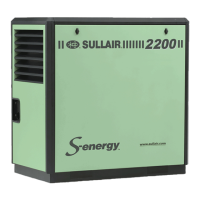Section 4
51
1800-3000 USER MANUAL
INSTALLATION
4.1 MOUNTING OF
COMPRESSOR
A suitable foundation or fabricated support must be
established to support the compressor. It should be
rigid enough to keep the compressor frame level and
maintain alignment of the compressor and motor.
Tie-down bolts of sufficient size must be used to
provide uniform contact between the foundation and
the compressor frame. Materials such as rubber or
cork can be used to provide uniform contact between
the foundation and compressor frame.
• Piping loads must be eliminated through
the use of flex connectors or other systems
which prevent piping loads from being
transmitted to the compressor.
• Special consideration should be made to
meet national and local electrical codes for
the required space around and in front of
the electrical panel. Lighting should be pro-
vided for future service requirements.
• Accessibility for fork lift trucks, overhead
cranes and maintenance vehicles should
be given careful consideration in order to
provide any maintenance that may be
required. Adequate space around the unit
should be provided for access to all com-
ponents of the compressor.
• Softer surfaces in walls or ceilings will
absorb sound and minimize ambient noise
levels. Harder, reflective surfaces will
increase ambient noise levels.
4.2 VENTILATION & COOLING
Air-Cooled Compressors
• An area with adequate space must be pro-
vided for the compressor and its compo-
nents. Air-cooled compressors require a
minimum of 4 feet (1.25 meter) around the
perimeter of the compressor.
• The location should be free from standing
water and allow access to clean air that is
free from exhaust and paint fumes, dust,
metal filings or caustic chemicals.
• Cooling air should be removed from the
area in order to prevent the re-introduction
of heated exhaust air back into the com-
pressor’s cooling system.
• Reduced headroom above the compressor
will require that cooling air be either ducted or
in some way deflected away from the com-
pressor. Inadequate ventilation will result in
higher ambient operating temperatures.
• If discharge/inlet ductwork is added to the
compressor package, then remove the lou-
vers from the compressor package.
NOTE
Ambient temperatures above 104˚F (40˚C)
require that the high ambient option is
specified for the compressor.
NOTE
Systems that employ both a conventional
reciprocating compressor and a screw-
type axial compressor must be isolated
from each other by use of a common
receiver tank. Individual airlines from
each compressor should be piped to the
common receiver tank.
NOTE
Shipping straps are painted red in order
to help identify them for removal. Be sure
to remove them prior to operation of the
drive assembly.

